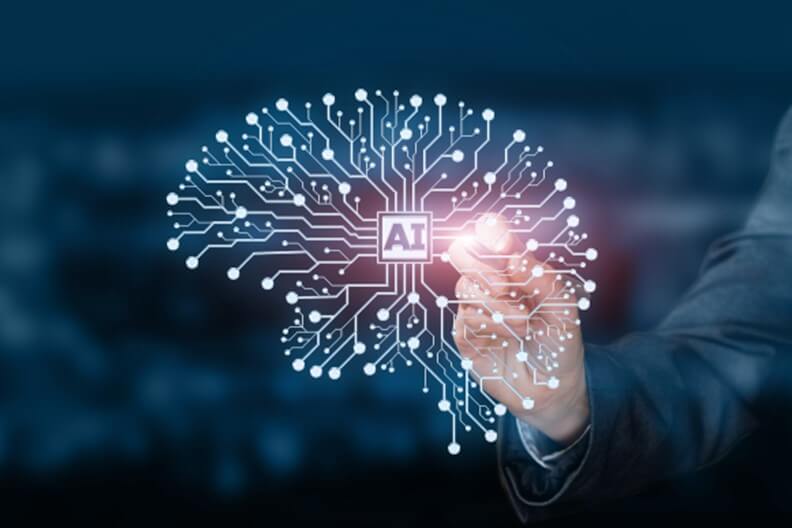Artificial Intelligence, also known as AI, has been around for years. In fact, if you’ve used a search engine, social media, or encountered a chatbot on a website, you’ve already experienced it. In the world before search engines or social media, people went to libraries and researched using microfiche or cards in little drawers. Simple tasks required more effort to answer basic questions such as the hours of operation or how to refill a prescription. Today, these tasks are easier, more convenient, and more efficient thanks to AI technology such as search engines, social media, chatbots, and ChatGPT.
Depending on your occupation, AI may strike fear or excitement. Despite predictions from companies such as Goldman Sachs (1) and IBM (2), AI is a long way from replacing people and their jobs. That’s not to say, however, that AI doesn’t benefit productivity in the workplace. Organizations should be aware that AI is a tool intended to aid in employee efficiency and productivity but is a poor substitute for a human worker.
If you’re seeking guidance on how to best implement AI in your organization, look no further. Below you’ll find helpful information to ensure your organization benefits from what AI has to offer without risking your organization’s reputation or security.
ENSURE YOU HAVE AN AI POLICY IN PLACE…
Protect sensitive and proprietary information and intellectual property.
AI adoption doesn’t come without risks. Before utilizing AI applications in your organization make sure you understand your professional responsibilities for compliance with ethical and privacy standards, regulatory compliance, and how to reduce the odds of costly violations. Additionally, you should have clear guidelines in place to ensure that your employees aren’t uploading or copy/pasting any sensitive, proprietary, privacy-protected, or intellectual property into an AI tool.
Prioritize human beings in your organization.
One of the simplest but often neglected ways to do this is by stating and demonstrating you value people first. Show your employees how much you appreciate them. Ensure they have the right resources and connections. Only then, offer opportunities to learn how to use AI ethically. Provide AI as an option to enhance productivity after they have exhausted other measures.
Clarify your organization’s expectations about ethical use and decision-making.
Ethical use of AI tools requires more than just sound judgment and doing the right thing even when no one is watching. When using AI tools decision-making will be crucial. Decision-making is a multi-step process that involves gathering information, sorting through it, looking at the options and alternatives, weighing everything, making a choice, taking action, and then making a decision. But a good decision-maker should prioritize what’s best for the organization, themselves, and other parties.
Define that AI is a productivity aid, not a replacement for doing the actual work.
Clarify that AI tools can be used to help with general research, idea generation, or brainstorming. In other words, your organization values doing things both efficiently and effectively. However, you value doing things with thoughtful intent and doing it right the first time to avoid costly mistakes or damage to an individual’s or the organization’s reputation even more.
Establish guidelines about content to assure that anything produced by AI is limited to internal use.
Employees must always rewrite AI-generated content from their unique perspective (and where relevant, the brand’s voice), fact check, run content past a subject matter expert, etc. Alternatively, graphics and video generated by AI should be utilized as internal templates or mock-ups for design or production teams where customization, your organization’s own images, etc. can be substituted so you can limit the risk of infringing on another’s intellectual property or rights.
Specify that AI-generated content, specifically when used on the web, goes against Google’s webmaster guidelines. (3)
Therefore, it is strongly advised that your organization’s AI use policy prohibits the sharing, publishing, reproducing, or distributing of AI-generated content in its raw form anywhere but especially on the Internet.
Determine how or if you want to acknowledge the use of AI in your creative process in published works.
While there is no hard or fast rule, there is a question of transparency when it comes to the creation of content. Some argue that you should give credit to the specific tool with something such as “[AI tool] was utilized as a part of our creative process. However, the work within this article is our own unless otherwise stated or licensed for use.” Others argue that if the content is yours, it doesn’t matter what’s behind the creative process. Therefore, it is advised that you seek appropriate legal advice for guidance on this specific matter.
… AND AN AI COMPLIANCE OFFICER
AI technology is changing at lightning speed.
It doesn’t matter how little (or how much) AI is incorporated into your business, someone still needs to manage the details of security, regulatory, and privacy compliance among other things. This may be a team of people or an individual depending on the size of your AI initiatives. Factors you should consider include:
- Security and Privacy – ensures that teams using AI technology aren’t disclosing information that would harm your organization or another party.
- Discrimination – investigates AI-powered technology to evaluate for discrimination, manipulation, or deception especially against certain protected groups or individuals.
- Laws and Regulations – verifies that your organization and employees using AI technology aren’t breaking laws or regulations.
- Ethics and Transparency – assures that your organization and more specifically the employees using AI-powered technology are using it responsibly, ethically, and in transparency.
TREAT YOUR PEOPLE AS YOUR NUMBER ONE ASSET
Learning is essential to human progress.
Employees at all levels must develop problem-solving and critical thinking. They must also continue to further develop skill expertise, enhance knowledge, and gain experience. Failure and mistakes are part of the learning process as are obstacles and resilience. AI doesn’t have these capabilities which is what makes humans special, unique, and your organization’s most valuable asset.
Experiences matter, especially when they involve interaction with other people.
Peer mentoring, collaboration, teamwork, communication, respect, appreciation, networking, service, and support are among some of the traditional learning experiences that AI can’t provide to an organization’s culture where employees are engaged and productive.
Decision-making is a human skill.
AI can be valuable a tool when utilized to enhance the productivity of human workers, not to replace the humans using them. However, AI lacks an understanding of a decision and its consequences. Furthermore, AI doesn’t have context, hasn’t gathered the relevant information, hasn’t considered options or alternatives, and lacks the critical skills to make a decision that is in the best interest of all parties. Humans have unique skills that AI lacks which is to consider factors outside of a machine’s capability such as empathy, extraordinary circumstances, the severity of consequences, the urgency of action, and so forth.
UNDERSTAND THE FLAWS OF AI
AI tools can suffer from “hallucinations.”
Hallucinations are most easily explained as an output that’s different than what you would expect. Often these are convincing responses but are flawed, aren’t accurate, don’t exist, or are entirely fictitious replies. When confronted, some AI tools will acknowledge a faulty response (or misinformation) citing it was an example or it was intended to be replaced with actual research. A few examples:
- Scholarly references and citations often don’t exist or can’t be found.
- Statistics and facts are often false, inflated, or don’t exist.
- Images often don’t match the text requested.
Example: In a hilarious test in 2021 at the University of California, Berkley AI found pandas in images of bicycles and giraffes. (4)
Information is often outdated
AI technology such as ChatGPT and others is often outdated by at least 2 years. It doesn’t have the ability to pull from newsfeeds, current events or even social media feeds about relevant topics about what’s happening “right now.” For example, if you’re doing simple research on what product is best to replace your office copier, you may want to utilize another tool that has the capability to draw from real-time information.
AI tools can produce deepfakes.
Deepfakes use synthetic media to imitate the likeness or voice of someone else. In May 2023, Senator Richard Blumenthal opened a senate hearing with a deepfake of his own voice. (5) This was to demonstrate the capability of some AI tools such as ChatGPT.
AI is Open Source or Opt-In
AI tools are still computers. They require input to formulate output. The more users that interact, upload, or otherwise freely share information the greater the odds are that there will be some kind of invasion of privacy, social grading, discrimination, and manipulation that occurs. Search engines and social media have been experimenting with algorithms for years, if not decades, on how engagement and other factors influence what appears after a search query is performed or within a feed of an individual user, or how to minimize bias. Ultimately AI still hasn’t solved the problems with Open Source, opt-in, and bias. Here’s what this means to your organization:
- Be aware that what information is inserted into AI technology should be something your organization is comfortable with broadcasting. In other words, don’t share trade secrets, sensitive or confidential information, intellectual property, and so forth.
- Code generated by AI technology, like any Open Source software, script, or code is subject to vulnerability. This means it could be exploited or become part of someone else’s paid solution. Use AI as a tool to flesh out the basics but rewrite your own from scratch.
- Written content, regardless of its intended purpose, may pass a plagiarism test (at least at the time this article was written.) But it’s highly likely that it is, indeed, plagiarized content. Don’t forget that AI technology is fed by what others ask and upload and regurgitates based on what is already in its system.
- Along the same lines as plagiarism, content in all forms, including but not limited to text, images, photos, videos, spoken words, music, etc. may be protected by copyright law. Therefore, to avoid the potential of copyright infringement claims, be sure you use the output as a reference but do your own due diligence. AI tools may make the work more efficient, but it doesn’t eliminate the work entirely.
Remember AI has only one goal: output
When you think about a standard desktop printer it has one task. It pulls the paper in, prints the assigned document, and pushes out the finished printed piece. It can repeat this process over and over again with multiple documents. AI is like this because it has a goal which is to accomplish the task (or prompt) presented to it as quickly as possible. It doesn’t consider if the result is accurate, or if there might be consequences (such as violating copyright law or invading someone’s privacy, or being discriminatory.) AI just performs its job.
- Employees are essential to AI use because they are the conscience of your organization.
- Beware of the efficiency-effectiveness imbalance. AI can be extremely helpful to speed up processes, but it can also waste time if it results in inaccurate information. Identify the areas where AI is best suited for your organization and the methodology that will work best to ensure the desired balance between autonomy, and efficiency as well as effectiveness.
AI TIPS TO WORK SMARTER, NOT HARDER
Create a Prompt Log
Sharing prompts that generate the desired outcomes can be extremely valuable for your team. Once you find one that consistently works, log it and keep it in a knowledgebase or other system where your team has access to it.
| Prompt A prompt is a task or question that is assigned to AI. Here are some ChatGPT examples:
|
Ponder with AI
AI can be a great tool, especially for marketers and those who are essential to your organization’s key messages and content. Here are a few ways that you’ll find AI helpful:
- Create lists…
- For unique activities such as team-building and collaboration, icebreakers, networking, or spurring conversations about innovation.
- About niche topics for your blog.
- Concerning local and cultural customs in a specific city
- Easily provide a graphic mock-up for your design team to reference based on a concept you can quickly generate using AI.
- Develop a template that your content marketing team can enhance and then use to convert blog articles into videos.
- Establish a basic outline for an article – then you fill in the gaps with actual manual research and writing. PRO TIP: Stand out from your competition! In a world where more and more organizations are using AI to generate content, embed links, and include footnotes to sources. This not only demonstrates your content was created by a human, but that you put extra effort into your work.
- Produce a starting draft for a presentation on a specific subject.
- Brainstorm possible article titles, email subject lines, or calls to action.
Seek a Different Perspective
Your perspective is built on multiple factors including experiences, interactions, knowledge, gut feelings, and your conscience. AI can be a valuable tool, despite its own bias, to get a different perspective.
To avoid interfering with AI and influencing its response, begin first by writing your own bullet list or response to a critical question. Then ask only the question to AI and request specifically multiple perspectives on the matter.
This can be a helpful tool when you want to ensure you’ve covered all your bases such as preparing for a critical sales meeting and want to avoid potential objections or want to answer questions before they are asked. Or you’re attempting to negotiate a conflict, and you feel there are only one or two options but want to see if there are other ideas you haven’t explored.
The important factor when using AI is to avoid using it as a replacement or shortcut for thinking for yourself. Rather, you utilize it as a tool to learn and grow from. It can be even better when this is layered with peer mentoring or leadership coaching.
WITH GREAT POWER COMES GREAT RESPONSIBILITY
AI is a powerful tool that’s rapidly taking the world by storm. Like many technological advancements, AI comes with benefits and risks. It’s up to organizations and their leaders to ensure that when AI is utilized it is used for the benefit of all. Great content will never stop being valuable and meaningful. Essential tools such as AI will not just aid in efficiency, they will balance effectiveness and create the best outcomes for all parties.
Are you seeking meaningful corporate meetings or more engaged, productive employees? Contact Gavel International to learn more about our group travel incentive and meeting planning programs.
________________________________
SOURCES:
1 https://www.key4biz.it/wp-content/uploads/2023/03/Global-Economics-Analyst_-The-Potentially-Large-Effects-of-Artificial-Intelligence-on-Economic-Growth-Briggs_Kodnani.pdf
2 https://www.bloomberg.com/news/articles/2023-05-01/ibm-to-pause-hiring-for-back-office-jobs-that-ai-could-kill#xj4y7vzkg?leadSource=uverify%20wall
3 https://www.searchenginejournal.com/google-says-ai-generated-content-is-against-guidelines/444916/
4 https://www.sify.com/ai-analytics/the-hilarious-and-horrifying-hallucinations-of-ai/#:~:text=In%202021%2C%20University%20of%20California,seeing%20them%20everywhere%20as%20well
5 https://youtu.be/pXCFvJpsNJ4?start=7&end=124
This article was last updated on June 26, 2023
- Should Your Company Hire a Chief Metaverse Officer? - January 20, 2025
- Deepfakes Can Harm Your Company’s Reputation - December 30, 2024
- The Social Side Effects of Using Artificial Intelligence at Work - November 13, 2023






